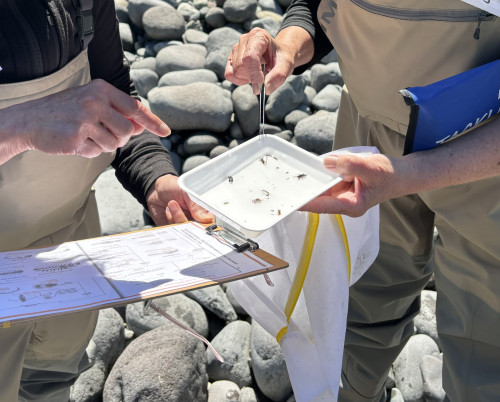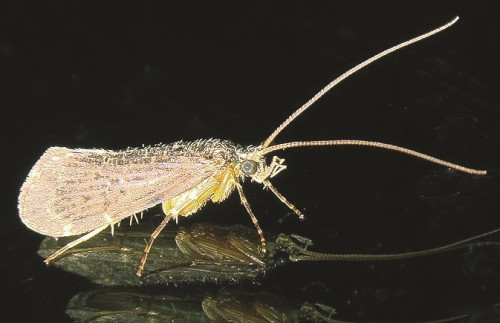Shifting from Sheer Luck to Sherlock
- 25/09/2024
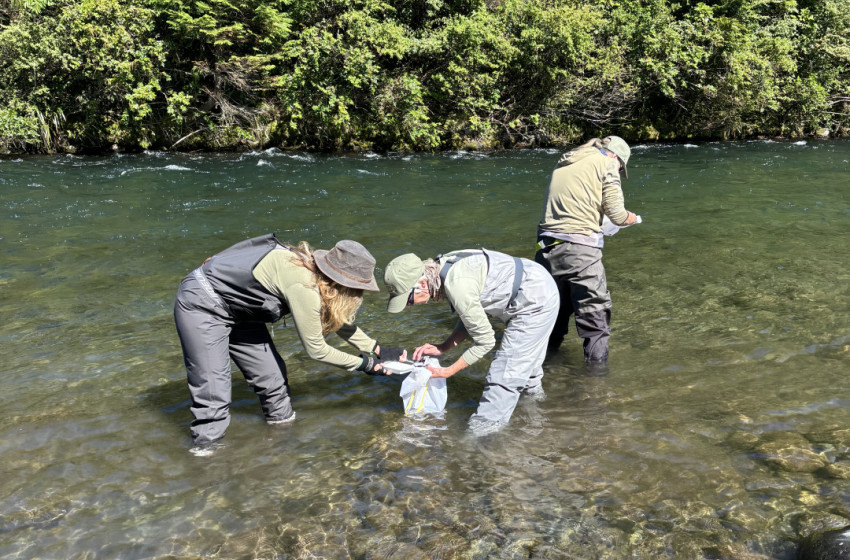
Dr Rachel McNae looks at ‘cracking the case’ with clues from the stream
“It’s a hatch,” he whispered.
We were surrounded by a quivering cloud of miniature beasts darting and hovering around
I panicked, inhaling a lungful of bugs, coughing and spluttering as they hit the back of my throat and crawled up my nasal passages. My brother simply sat there.
Calmly he cupped his hands amongst the blur of grey and brown and pressed his palms together. Opening his hands like a book he looked down. In between spits and coughing fits, through watering eyes, I was instantly mesmerised by the fuzzy bodies, the tiny wings, the scruffy hairlike protrusions. This was my totally unexpected and somewhat dramatic introduction to the world of entomology – the study of insects.
I am definitely no bug expert, however, my growing skills as a streamside sleuth have definitely made a huge difference to my fly fishing success. Entomology is the study of insects and their relationship to the environment where they live. As an angler entering into the entomological space, I understood the importance of knowing what trout were feeding on. However, how would I gather this knowledge and then apply it to my fishing? I saw entomology as an opportunity to garner clues and evidence in order to solve the complex mysteries of what trout wanted to eat, and when and where they wanted to eat it. I was instantly captured by this idea, but let’s be honest – I’m captured by any knowledge that may lead to better chances of enticing trout and broaden my appreciation for the natural environment where I spend much of my time!
As a youngster, I spent most of my winter school holidays on the edges of rivers and streams in the Central North Island. Looking back, and knowing what I know now, there are so many things I wish I’d taken more notice of, asked about, or been taught. The late cicada chorus, midges biting my ankles, darting shapes in the shallows, birds swooping and dipping from bank to bank were all important clues I missed back then.
A greater understanding of trout, what they eat and when may have helped me realise that the world of trout fishing extended beyond the same two flies I continually invested my hard-earnt pocket money in at the Hatepe Store – the insanely heavy double-eyed bug nymph with a huge double-eyed weighted glo-bug snagging their way along the river bottom. The more I have learnt about bugs and insects over the years, the more I now realise how much I didn’t know, and still don’t know!
So, with the familiar lyrics of UB40 now humming away in my head, I have reflected on what might be useful basic knowledge to help anglers ‘crack the case’ and gather and make sense of the clues rivers can provide, perhaps the most important being food sources. There are a multitude of resources out there in books and online that can help grow your knowledge of entomology in depth and breadth. Hatch calendars and species charts are useful reference points. However, some basic knowledge can go a long way to helping solve the mysteries our New Zealand rivers present.
Insights from Entomology
Understanding the unique characteristics, behaviours and life cycles of the insects which make up a trout's diet, can provide huge insights into when and how food becomes available to trout and their possible reaction to its presence. In New Zealand streams and rivers, mayflies, caddisflies, stoneflies, midges and terrestrial insects are amongst trout's preferred food items. Having a basic knowledge of these, including their stages of development (egg, larvae, pupae, emerger, adult) and their availability (time of year, season, day, water temperature), can help us adapt our fishing strategies to the trout's feeding patterns.
It can also help us select flies which may look more like the natural occurring food source. In turn, this knowledge can help us anticipate when and where trout are likely to be feeding, allowing us to strategically choose locations to fish, choose suitable approaches, flies, appropriate presentation techniques, time our mends and vary our drifts, anticipate the depths of food sources, and activate flies in certain ways. All of these are examples of key factors which can work together to increase the chances of a successful take.
Therefore, finding out what food sources might be present and being able to identify them is an excellent start.
Mayflies
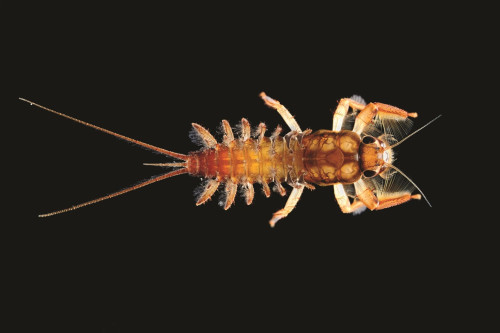
Mayfly Nymph - George Novak
Mayflies have four lifecycle stages – nymphs, emergers, duns and spent spinners. Adult female mayflies deposit their eggs on and under the water. The eggs hatch and spend most of their lives as nymphs underwater (one to two years), feeding on algae and detritus. They undergo multiple growth stages where they moult and increase in size. As it matures the nymph morphs into an emerger. It swims to the water's surface or crawls out onto vegetation. At this stage it is still not fully developed (kind of like adolescence) sporting a set of dowdy looking wings and looking relatively dull in appearance. It is the next stage where it sheds its dull nymphal skin reveals the final adult stage of the mayfly (dun) – a delicately winged, coloured insect capable of flying and reproduction. Identified by their upright wings which look like a sail boat, their lives are fleeting yet purposeful, living for between a few hours and a few days during which they mate and the females then lay their eggs on or below the surface of the water, and then die, falling onto the water surface (spent spinners).
Knowing these four lifecycle stages can help us to find flies in our fly box which are similar in profile, colour and size. Each stage of the mayfly life cycle moves through or on the water differently. For example, an emerger will rise through the water column due to the build-up of gas beneath the main nymph body and the soon-to-be-shed outer skin. Some anglers believe this is why the shiny beads on nymph flies attract the trout – it looks like an air bubble. The emerger can sit in the surface film, placing it in a highly vulnerable state. Whereas a spent spinner rests with its usually upright wings flat on the water surface in the final stages of its life making them easy targets for hungry trout… and the process repeats.
The ‘rise form’ from trout below can provide further clues as to what the trout are eating. For example, if they are dialled in to emergers we might observe the slight swirl of water caused by the fish’s tail. When spent spinners are on the menu, trout might appear more aggressive, coming out of the water to inhale the mayfly.
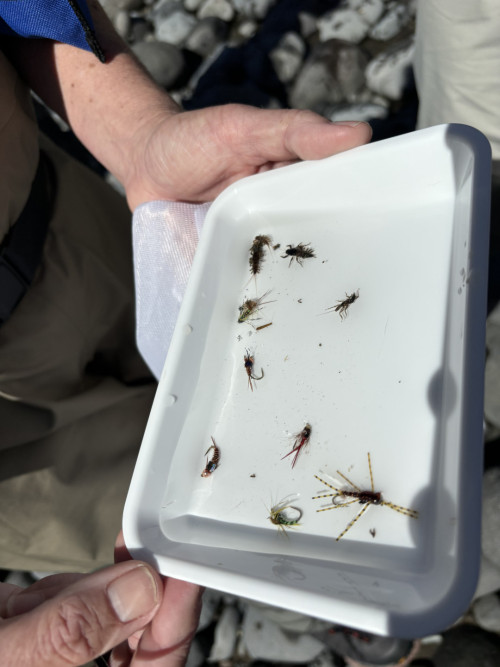
Comparing bugs to flies - DR Rachel McNae
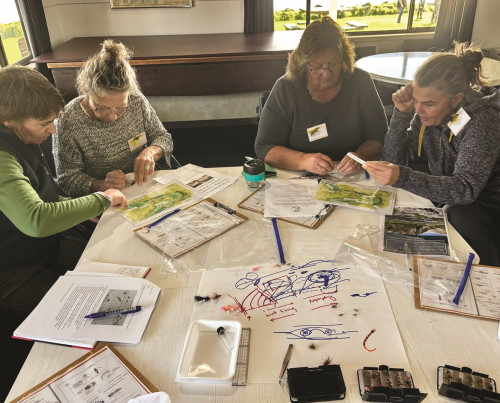
Brushing up skills at the Tauranga Club - Dr Rachel McNae
Adult Caddisfly - Phil Bendle, CitSci Hub NZ
Caddisflies
There are four key stages to the caddisfly life cycle: egg, larva, pupa and adult. The life cycle begins when female caddisflies lay their eggs on either the surface of the water, on overhanging vegetation, or by diving beneath the water surface. Caddisflies, unlike mayflies and stoneflies, undergo complete metamorphosis, going from egg form (one to three weeks) to larva form (nine to 10 months) to pupa (two to five weeks) to final adult (one to three weeks), taking approximately one year to develop.
Described as cased or uncased, some caddis larvae will build protective cases for themselves out of debris and sand, attaching themselves to rocks to mature. Others may take up protective residence in hollowed out reeds or sticks; these are termed cased caddis. Some varieties are free swimming or uncased.
When the caddisfly larva reaches maturity, it attaches to a solid substrate and constructs a pupal case to undergo metamorphosis into the pupal stage. The pupal stage is transitional. After a couple of weeks, the pupa swims up to the surface of the water where it sheds its pupal form and emerges as an adult fly (often evidenced by the shucks on the water surface). This is often the stage we are trying to imitate with our nymphs, right before the fully developed adult caddisfly emerges, which is when we might swap to a dry fly. The adult caddisfly looks a lot like a moth. They do not have a tail, but sport two pairs of hairy wings which fold over their backs and look like a tent when at rest. Similar to the mayfly, adult caddisflies have relatively short lives, typically living only a few days to a few weeks to fulfil their main purpose – reproduction, and then they die.
Stoneflies
Adult Stonefly - Nick King
Stoneflies are often found in cool water systems running over gravel or stony riverbeds. Stonefly nymphs hatch from eggs deposited on submerged or overhanging surfaces such as rocks or vegetation in or near the river. These nymphs are well adapted for life in flowing streams and rivers, with robust bodies, well-developed legs, and functional gills.
They are carnivorous and feed on various aquatic invertebrates. Undergoing multiple moults as they grow and develop, they can take several months to several years to mature, depending on the species and environmental conditions. When stonefly nymphs reach maturity, they crawl out of the water onto nearby rocks or vegetation, and their exoskeleton splits open to reveal the adult stage with two tails, and pairs of distinctive veined wings that fold flat over their backs. They can live for several weeks and after mating the females return to the river to lay eggs.
The main colouring of adult stoneflies are green, brown and black, so it pays to have a couple of each colour in your fly box in a range of sizes.
Terrestrials
During the warmer months, particularly in late summer and early autumn, land-dwelling food sources: ants, wasps, bees, beetles, crickets, blowflies, spiders, cicadas and sometimes even mice, may become a substantial part of a trout's diet. These morsels inadvertently fall into the water from overhanging vegetation or are blown in by the wind, creating a feast for opportunistic trout. This natural occurrence provides anglers with excellent chances to mimic these sources and entice trout to strike.
Terrestrial patterns are versatile and can be effective in various water conditions, such as small streams, large rivers, or still waters. Throughout the summer (December-February) manuka beetles (green or brown beetles) appear on bush-lined streams and rivers, effective in early parts of the season. Cicadas often emerge in late January and February, and their chorus is considered a critical indicator for tying a cicada pattern into your line. Blowflies, various spiders and ants can be found all year around, and the willow grub, while not strictly terrestrial, falls into streams from the leaves of willow trees from December to March.
February sees the presence of the cranefly and sawfly, and from late summer through to early autumn (February-April) most terrestrial insects are still present and effective. As the season progresses into autumn, terrestrial insect activity generally winds down, and aquatic insects like mayflies become more prominent.
Green Beetle - Nick King
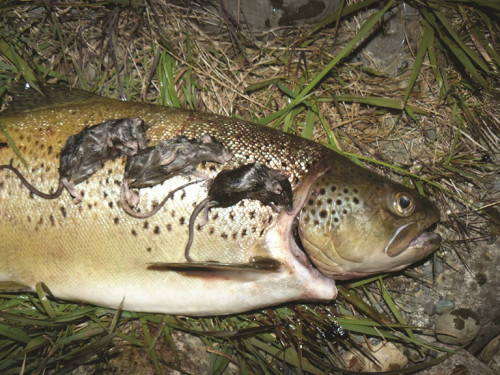
Ants, wasps, bees, beetles, crickets, blowflies, spiders, cicadas and sometimes even mice, may become a substantial part of a trout's diet - Paul Stenning
Being a Streamside Detective
Making notes and recording observations can help to hone your detective skills and bring pieces of the puzzle together. There are some basic tools which you can carry with you to help you identify what you find – white gauze cloth bag or seine net, small white dish or tray, tweezers, magnifying glass, bug books or charts.
Turning over rocks on the side of the river to see what is underneath, and scuffing your boot on the riverbed and using the gauze cloth to capture what might lie in the substrate, can help identify what food sources are present. Inspecting the stomach contents of a fish destined for the smoker is also a way to find out what they are eating. Important observations include date, size, colour, and stage of lifecycle.
Working from a position of ‘Sherlock’ rather than ‘sheer luck’ means making sense of our observations and from the clues presented to us to solve the puzzle. All your senses are important in this process: what do you hear? Is that a cicada chirp? What do you see, was that the swirl of a tail? Beams of sunlight hitting weed beds? What do you feel – a drop in temperature? Temperature changes are often catalysts for changes in diet available to trout. How about an increase in wind strength which might blow terrestrial insects from overhanging trees onto the water surface?
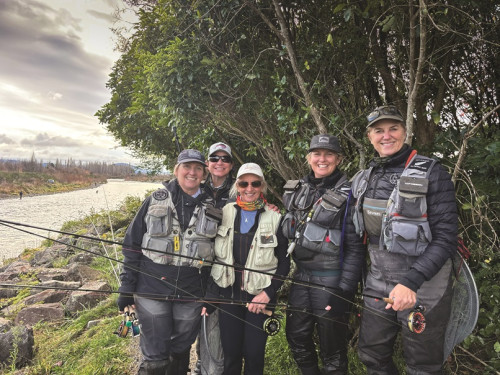
Anglers putting into practice what they've learnt studying stream insects - Dr Rachel McNae
Being aware of your surroundings and noticing how the context changes, allows you to respond effectively and make good decisions about what setup to use, which flies might work and how you might fish them. And if you are unsure, be creative. For example, set up a dry dropper rig, with a dry fly which mimics a dun and a wet fly which could be seen as an emerger. Notice which fly is being hit, and this might indicate what the trout are dialled into at that particular time, or where they are sitting in the water column. Or even better, have some of those special flies which look like nothing specifically but could be entirely anything!
I am a firm believer that when it comes to fly fishing riverside and streamside sleuthing can shift you along the continuum of success. So, before you habitually reach for the double bug eye and egg, expand and draw on your entomological thinking. Take a moment to observe, gather your clues together to make some informed decisions to crack the case.
